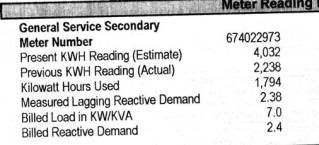Since we are talking about such things, the power company recently installed a kvar meter at my carwash. I cannot understand what is going on anymore. It used to be that they read the meter and obtained the kwh and demand, then computed the bill. I pretty much got that ok. Now, here is a copy of my latest bill:
Can any of you gents explain to me what is going on.
About 10 days before this bill came out, I read the meter myself. It gives 3 numbers or readings. Here were my readings:
#1 3521 kwh
#2 9.07 kw
#3 4.54 kvar
Now, I get that the 3521 kwh is my total use, to date. The bill has them estimating my total @4,032, which is probably a little low (I haven't read the meter lately). The bill states my load is "7.0", where they are getting that is beyond me. It is not a reading that is available to me, unless it is somehow calculated from the 3 numbers displayed. It may also be that the #2 reading of 9.07 is the load, what say you.
I hear you talk about PF in relation to kvar, but is there any indication of what my PF is, based on these meter readings or billing information?



